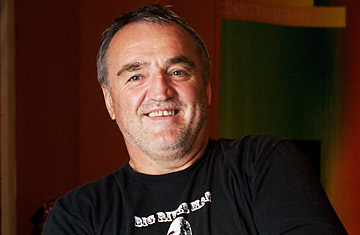
In 2007, Slovenian Martin Strel became the first person to swim the Amazon River — all 3,300 miles of it — an odyssey that saw him battling parasites, piranhas and man-hungry Amazonian women. The laid-back Strel, who didn't swim his first river until after the age 50, talked to TIME about his training regimen — which includes copious amounts of wine. A documentary film chronicling his swim, Big River Man, was released last week.
You didn't start swimming rivers until you were in your 50s. What got you into it?
My life is very connected to water. I grew up in this very special part [of Slovenia] where there's a lot of water, many lakes, rivers, creeks. My first swimming competition was when I was 10 years old, and my whole village was talking about my power: "How is this small guy so strong?" In 1978, I decided to become a professional marathon swimmer, so I've been a professional for 31 years.
How did you take the leap from pool to wilder terrain?
My idea wasn't to be a world champion or Olympic champion. I started with a professional group, and did world events. There was a war in Yugoslavia, Sept. 11th happened, and I decided that the world was changing, and so I would do something new. I started swimming lakes, rivers and oceans around the world. Before I knew it, I was thinking about the Amazon, and I finally did it. Don't ask me what I'm doing next.
I've read that you're not going to tackle the world's longest river, the Nile, because it's too slow and shallow — so it's not much of a challenge.
I've swam about 850 miles of the Nile, from near Alexandria and the Mediterranean to Sudan. It's in my head now, believe me. It's possible.
You've swam the Yangtze, the Danube, the Mississippi Rivers. How do you train for these swims?I train twice a day. In the morning six to eight, and again in the afternoon. In the winter, I do a lot of cross-country skiing, hiking, gymnastic exercises. I try not to do any cycling or running — because I'm heavy, and I need the fat for a long swim. Fat is my power.
My body's pretty special — I'm never hurt or sick. If everyone were like me, all of the hospitals around the world would be empty.
Tell me about your diet.
I drink my wine every day. This is special wine made in Slovenia, you can't buy it outside the country. Even though I drink a little more than usual, it has less alcohol and sugar, so it's good for me. This is my idea, not my doctor's idea.
I understand you also do this while you're on a swim.
It helps me a lot, believe me. I could swim 10-12 hours every day like this. I tested many different sorts of wines, and I found this one in 2000. My feeling was, "Beautiful," and we've been together ever since.
How much wine do you drink a day?
Max is two bottles.
What special preparations did you undertake for the Amazon?
Swimming the Amazon is different from any other place I've been. The sun is a big enemy, it can destroy your face with sunburn in a few days. You have to know all about the parasites. If you get them in your blood, you're dead. You can even die a few years later, once you're at home. I wore a wetsuit with lanolin and Vaseline to block them out.
I got infected with Dengue fever — but I didn't develop it. I found out after my swim when I was at the doctors. So the tropical diseases are a huge risk.
What about the wildlife?
I was attacked by piranhas a few times — at one point they were eating my back. We found a good way to prevent them from attacking was to pour buckets of putrid blood into the water. You can redirect them pretty easily.
Also I learned not to pee in the water because there are candiru. These are the most dangerous fish in the world. It's only two or three inches, but it's one of the fastest. It swims into your penis, or in your mouth or nose or ears, lodges in there and eats your blood.
There's also bullsharks and stingrays — my son was attacked by one on a shore, and even with doctors around us, it was quite scary. There were pink dolphins that swam with me for many days — I think they were my best protection against the bullsharks.
Did you have much interaction with the indigenous people in the Amazon?
Before I went, people told me: "Martin, you know what the most dangerous thing in the Amazon is? The women." So I said, "Big surprise." But then they told me, "No Martin, there are places where you can see 15 to 20 times more women than men and these women are very aggressive. They'd like to catch you to marry you." And I found out it was true, so I made sure my security was very strong.
You have been called "The Hero in a Speedo." Tell me about some of your motivations for swimming.
Right now, my job is to go around the world to talk about this Amazon story, work on stopping people who'd like to destroy this precious part of the world that we have to save. Most people don't understand the implications of Amazon deforestation and what it means for global warming.
So you're raising money for this?
We launched an international fund last year, and so far we've gotten money from Norway's prime minister, Jens Stoltenburg, who has pledged $1 billion. Now we've gotten Sweden, Japan, Germany, Switzerland and Brazil involved — it looks pretty good for the future.
